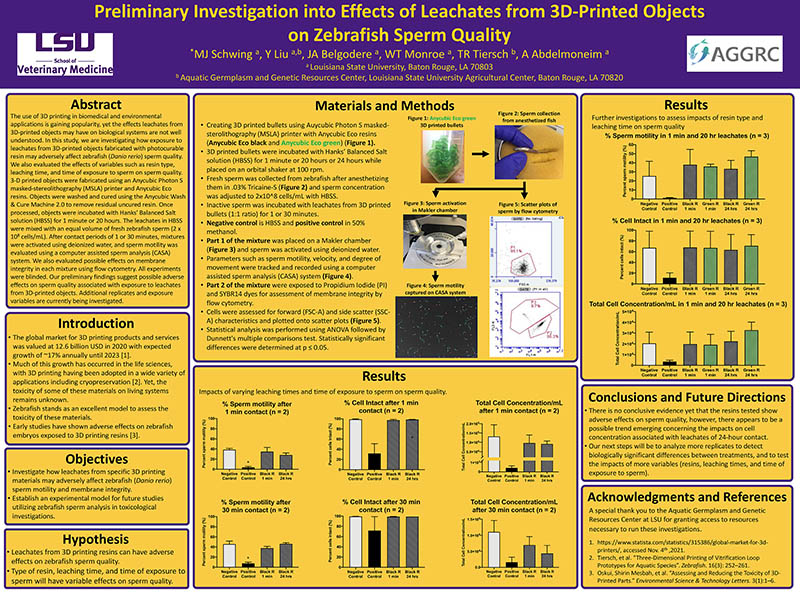
Hover to pan and click to magnify. Click again to pan at full screen.
*MJ Schwing a, Y Liu a,b, JA Belgodere a, WT Monroe a, TR Tiersch b, A Abdelmoneim a
*MJ Schwing a, Y Liu a,b, JA Belgodere a, WT Monroe a, TR Tiersch b, A Abdelmoneim a
a Louisiana State University, Baton Rouge, LA 70803
b Aquatic Germplasm and Genetic Resources Center, Louisiana State University Agricultural Center, Baton Rouge, LA 70820
ABSTRACT:
The use of 3D printing in biomedical and environmental applications is gaining popularity, yet the effects leachates from 3D-printed objects may have on biological systems are not well understood. In this study, we are investigating how exposure to leachates from 3D-printed objects fabricated with photocurable resin may adversely affect zebrafish (Danio rerio) sperm quality. We also evaluated the effects of variables such as resin type, leaching time, and time of exposure to sperm on sperm quality. 3-D printed objects were fabricated using an Anycubic Photon S masked-stereolithography (MSLA) printer and Anycubic Eco resins. Objects were washed and cured using the Anycubic Wash & Cure Machine 2.0 to remove residual uncured resin. Once processed, objects were incubated with Hanksʹ Balanced Salt solution (HBSS) for 1 minute or 20 hours. The leachates in HBSS were mixed with an equal volume of fresh zebrafish sperm (2 x 108 cells/mL). After contact periods of 1 or 30 minutes, mixtures were activated using deionized water, and sperm motility was evaluated using a computer assisted sperm analysis (CASA) system. We also evaluated possible effects on membrane integrity in each mixture using flow cytometry. All experiments were blinded. Our preliminary findings suggest possible adverse effects on sperm quality associated with exposure to leachates from 3D-printed objects. Additional replicates and exposure variables are currently being investigated.

DISQUS COMMENTS WILL BE SHOWN ONLY WHEN YOUR SITE IS ONLINE